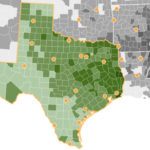AUSTIN—Despite some signs of economic recovery, about one in five Texans in 2012 had limited or uncertain access to enough food to support a healthy lifestyle, new research revealed.
A study released by the Texas Food Bank Network showed 18.3 percent of Texans lived in food-insecure homes in 2012, including 1.9 million children.
 Ferrell Foster“One percent would be too high, but 18 percent is grievous,” said Ferrell Foster, director of ethics and justice with the Texas Baptist Christian Life Commission. “These are our neighbors, friends and family. We like to brag about the greatness of Texas, but this is not a sign of greatness.”
Ferrell Foster“One percent would be too high, but 18 percent is grievous,” said Ferrell Foster, director of ethics and justice with the Texas Baptist Christian Life Commission. “These are our neighbors, friends and family. We like to brag about the greatness of Texas, but this is not a sign of greatness.”
Research conducted by Feeding America showed more than 4.77 million Texans experienced food insecurity in 2012, a marginal improvement over the 4.81 million food-insecure people the previous year.
Food insecurity means lack of money or other resources at some times during the year limits consistent access to adequate food, according to the U.S. Department of Agriculture. In food-insecure households, family members often cut back on groceries—or buy cheaper, unhealthy food—to pay for lodging, utilities or medicine.
The data revealed pervasive food insecurity throughout the state, with the highest concentration in Southeast Texas near Houston and Beaumont.
 Jeremy EverettJeremy Everett, director of the Texas Hunger Initiative, a collaborative project developed in the Baylor University School of Social Work in cooperation with the Texas Baptist Christian Life Commission, noted the Feeding America research appeared consistent with what his organization had observed.
Jeremy EverettJeremy Everett, director of the Texas Hunger Initiative, a collaborative project developed in the Baylor University School of Social Work in cooperation with the Texas Baptist Christian Life Commission, noted the Feeding America research appeared consistent with what his organization had observed.
“It is more than unfortunate that we have not incorporated low-income families into the ‘Texas Miracle’ or the recent economic success we have been experiencing as a state,” Everett said. “Texans touting the ‘Texas Miracle’ will continually be seen as hypocritical when we flaunt the success of our economic model when record numbers of Texans are falling into poverty. We have to do a better job of creating economic opportunities for all of our brothers and sisters living in impoverished conditions.”
Nationally, Feeding America reports 48.9 million Americans—16 million of them children—experience food insecurity. In a county-by-county comparison, Harris County, home to Houston, ranks fourth nationally, with 765,970 food-insecure residents, and Dallas County ranks sixth, with 476,540 food-insecure residents.
Sign up for our weekly edition and get all our headlines in your inbox on Thursdays
Texas ranks ninth for child food insecurity at 27.4 percent. In Zavala County, 41 percent of children are food-insecure—the highest rate in the nation.
 The Howard G. Buffett Foundation, ConAgra Foods Foundation and Nielsen provided support for the research. Findings, including an interactive map, are posted at www.feedingamerica.org/mapthegap.
The Howard G. Buffett Foundation, ConAgra Foods Foundation and Nielsen provided support for the research. Findings, including an interactive map, are posted at www.feedingamerica.org/mapthegap.
“Studies like these underline how hunger can persist even when the economy seems to be getting better,” said Celia Cole, chief executive officer of the Texas Food Bank Network. “Texas leads the nation in many ways, but we can’t be proud of ourselves as a state until this problem has been solved by our leaders and our local communities. Hunger does not belong here.”
The prevalence of food insecurity underscores the need for Christians to be involved both in advocacy for more just public policy and in giving generously to ministries that help hungry people, added Foster, coordinator of the Texas Baptist Hunger Offering.
“Texas Baptists have a special opportunity on Mother’s Day to give money for the hungry as a means of honoring our moms,” he said.














We seek to connect God’s story and God’s people around the world. To learn more about God’s story, click here.
Send comments and feedback to Eric Black, our editor. For comments to be published, please specify “letter to the editor.” Maximum length for publication is 300 words.